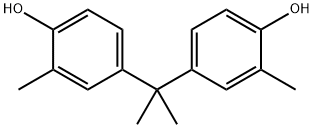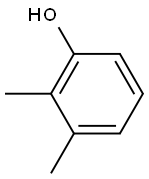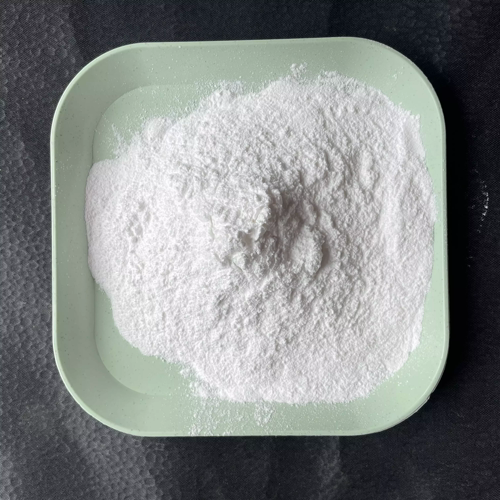2,2-Bis(4-hydroxy-3-methylphenyl)propane
Synonym(s):4,4′-Isopropylidenedi-o-cresol
- CAS NO.:79-97-0
- Empirical Formula: C17H20O2
- Molecular Weight: 256.34
- MDL number: MFCD00002232
- EINECS: 201-240-0
- SAFETY DATA SHEET (SDS)
- Update Date: 2024-12-18 14:08:52

What is 2,2-Bis(4-hydroxy-3-methylphenyl)propane?
Description
2,2-Bis(4-hydroxy-3-methylphenyl)propane is a monomer of polycarbonate and bisphenol A. It has been used as a reaction solution for sodium salt and calcium stearate. The product contains hydrogen chloride and hydrochloric acid as byproducts. This product also reacts with fatty acids to produce aromatic hydrocarbons.
Chemical properties
Powder or crystalline or crystalline powder or chunks
The Uses of 2,2-Bis(4-hydroxy-3-methylphenyl)propane
Used as a color-developer in thermosensitive recording materials.
Preparation
The preparation of 2,2-Bis(4-hydroxy-3-methylphenyl)propane is as follows:In a full-jacket type 1 L separable flask equipped with a thermometer, a stirrer, and a 100 mL dropping funnel, 26.1 g (0.4 mol) of isopropyl alcohol was added under a nitrogen atmosphere, and then 58.3 g (0.5 mol) of 90% by weight sulfuric acid was slowly added thereto. Thereafter, 54.5 g of toluene, 191.5 g (1.8 mol) of ortho-cresol, and 5.5 g (0.03 mol) of dodecanethiol were added thereto, followed by setting the temperature in the separable flask to 40° C. In the dropping funnel, 42.5 g (0.7 mol) of acetone was placed, and it was slowly fed dropwise to the separable flask for 30 minutes. After completion of the dropwise addition of acetone, the reaction was allowed to proceed at 40° C. for 2 hours. After completion of the reaction, 100.0 g of toluene and 100.0 g of demineralized water were fed, and the temperature was increased to 80° C. After the temperature reached 80° C., the reaction liquid was left to stand to confirm that the precipitates generated during the reaction were dissolved into the organic phase and the aqueous phase. This was followed by extraction of the aqueous phase in the lower layer. Thereafter, saturated sodium hydrogen carbonate solution was added to the obtained organic phase to allow neutralization, followed by confirming that the pH of the aqueous phase in the lower layer, became not less than 9. After extraction of the aqueous phase in the lower layer, demineralized water was added to the obtained organic phase, and the resulting mixture was stirred for 10 minutes. Thereafter, the mixture was left to stand, and the aqueous phase was extracted. Part of the obtained organic phase was removed, and subjected to high-performance liquid chromatography to analyze the amount of bisphenol C produced. As a result, the reaction yield in terms of acetone was found to be 84 mol %.

Definition
ChEBI: 3,3'-Dimethylbisphenol A is a bisphenol.
Flammability and Explosibility
Not classified
Properties of 2,2-Bis(4-hydroxy-3-methylphenyl)propane
| Melting point: | 138-140 °C(lit.) |
| Boiling point: | 238-240 °C12 mm Hg(lit.) |
| Density | 1.0421 (rough estimate) |
| vapor pressure | 0Pa at 25℃ |
| refractive index | 1.5000 (estimate) |
| solubility | almost transparency in Methanol |
| form | solid |
| pka | 10.45±0.10(Predicted) |
| form | solid |
| color | White to Almost white |
| Water Solubility | 22mg/L at 20℃ |
| Stability: | Hygroscopic |
| CAS DataBase Reference | 79-97-0(CAS DataBase Reference) |
| NIST Chemistry Reference | Phenol, 4,4'-(1-methylethylidene)bis[2-methyl-(79-97-0) |
| EPA Substance Registry System | Phenol, 4,4'-(1-methylethylidene)bis[2-methyl- (79-97-0) |
Safety information for 2,2-Bis(4-hydroxy-3-methylphenyl)propane
| Signal word | Warning |
| Pictogram(s) |
 Exclamation Mark Irritant GHS07 |
| GHS Hazard Statements |
H315:Skin corrosion/irritation H319:Serious eye damage/eye irritation H335:Specific target organ toxicity, single exposure;Respiratory tract irritation |
| Precautionary Statement Codes |
P261:Avoid breathing dust/fume/gas/mist/vapours/spray. P264:Wash hands thoroughly after handling. P264:Wash skin thouroughly after handling. P271:Use only outdoors or in a well-ventilated area. P280:Wear protective gloves/protective clothing/eye protection/face protection. P302+P352:IF ON SKIN: wash with plenty of soap and water. P305+P351+P338:IF IN EYES: Rinse cautiously with water for several minutes. Remove contact lenses, if present and easy to do. Continuerinsing. |
Computed Descriptors for 2,2-Bis(4-hydroxy-3-methylphenyl)propane
| InChIKey | YMTYZTXUZLQUSF-UHFFFAOYSA-N |
2,2-Bis(4-hydroxy-3-methylphenyl)propane manufacturer
Deepak Novochem Technologies Ltd
New Products
Tert-butyl bis(2-chloroethyl)carbamate (S)-3-Aminobutanenitrile hydrochloride N-Boc-D-alaninol N-BOC-D/L-ALANINOL N-octanoyl benzotriazole 3-Morpholino-1-(4-nitrophenyl)-5,6-dihydropyridin- 2(1H)-one Furan-2,5-Dicarboxylic Acid Tropic acid Fmoc-Val-Cit-PAB DIETHYL AMINOMALONATE HYDROCHLORIDE 1,1’-CARBONYLDIIMIDAZOLE R-2-BENZYLOXY PROPIONIC ACID 1,1’-CARBONYLDI (1,2-4 TRIAZOLE) N-METHYL INDAZOLE-3-CARBOXYLIC ACID (2-Hydroxyphenyl)acetonitrile 4-Bromopyrazole 5-BROMO-2CYANO PYRIDINE 5-broMo-2-chloro-N-cyclopentylpyriMidin-4-aMine 2-(Cyanocyclohexyl)acetic acid 4-methoxy-3,5-dinitropyridine 2-aminopropyl benzoate hydrochloride 1-(4-(aminomethyl)benzyl)urea hydrochloride tert-butyl 4- (ureidomethyl)benzylcarbamate diethyl 2-(2-((tertbutoxycarbonyl)amino) ethyl)malonateRelated products of tetrahydrofuran








You may like
-
 79-97-0 Bis-o-cresol A 98%View Details
79-97-0 Bis-o-cresol A 98%View Details
79-97-0 -
 2,2-Bis(4-hydroxy-3-methylphenyl)propane CAS 79-97-0View Details
2,2-Bis(4-hydroxy-3-methylphenyl)propane CAS 79-97-0View Details
79-97-0 -
 Bisphenol c 95% CAS 79-97-0View Details
Bisphenol c 95% CAS 79-97-0View Details
79-97-0 -
 2,2-Bis(4-hydroxy-3-methylphenyl)propane CAS 79-97-0View Details
2,2-Bis(4-hydroxy-3-methylphenyl)propane CAS 79-97-0View Details
79-97-0 -
 1975-50-4 98%View Details
1975-50-4 98%View Details
1975-50-4 -
 14714-50-2 (2-Hydroxyphenyl)acetonitrile 98+View Details
14714-50-2 (2-Hydroxyphenyl)acetonitrile 98+View Details
14714-50-2 -
 118753-70-1 98+View Details
118753-70-1 98+View Details
118753-70-1 -
 733039-20-8 5-broMo-2-chloro-N-cyclopentylpyriMidin-4-aMine 98+View Details
733039-20-8 5-broMo-2-chloro-N-cyclopentylpyriMidin-4-aMine 98+View Details
733039-20-8